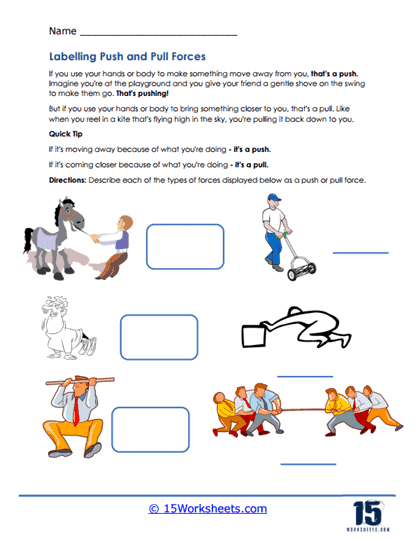

These worksheets are helpful when learning physics concepts and physical science material related to forces, motion, and interactions between objects. These worksheets are designed to engage students in active learning, reinforce their understanding of theoretical concepts, and provide them with opportunities to apply their knowledge to solve problems.
Identifying Types of Forces – These problems will present different scenarios, and students will need to determine the type of force at work. For example, “When you pull a door open, what kind of force are you using?” The answer is a “pulling force”. Students learn to identify forces like gravity (what keeps us on the ground), friction (what makes it hard to slide on carpet), and tension (like in a stretched rubber band).
Calculating Force – Here, students might be given the mass (how much matter is in an object) and acceleration (how fast something is speeding up) of an object and asked to calculate the force using Newton’s second law (Force = mass x acceleration). For instance, “If a car has a mass of 1,000 kilograms and accelerates at 2 meters per second squared, what is the force?” This teaches students to apply formulas and understand the relationship between mass, force, and acceleration.
Understanding Motion – These problems might ask students to describe the motion of an object. For instance, “If a ball is rolling down a hill and then rolls on a flat surface, what happens to its speed?” Here, students will learn that the ball speeds up when going downhill (due to gravity) but slows down on a flat surface (because of friction).
Predicting Outcomes – Some questions will present scenarios and ask students to predict what will happen based on their knowledge of forces and motion. For example, “If you were to slide down a slide covered in sandpaper versus one that’s smooth, which one would slow you down faster?” Students would use their understanding of friction to predict that the sandpaper slide would slow them down more.
Comparing and Contrasting – Here, students might be asked to compare two different forces or types of motion. For example, “How is the motion of a bicycle different from the motion of a spinning top?” With such questions, students learn to think critically and distinguish between different concepts in forces and motion.
Real-world Applications – These problems connect what students learn about forces and motion to the real world. They might be asked, “Why do you lean forward when a bus suddenly stops?” Through this, students realize that the concepts of forces and motion are not just textbook ideas but are happening all around them every day.
What is Force?
Force is a push or a pull on an object. It can make things move, stop, or change direction. Think about playing tug-of-war with your friends. The pull you exert on the rope is a force. Or, when you kick a soccer ball, the push you give is also a force.
What is Motion?
Motion refers to any movement or change in position of an object. When you run, you are in motion. When a car drives down the street, it’s in motion. Motion can be as small as a pencil rolling off a table or as vast as Earth rotating around the sun.